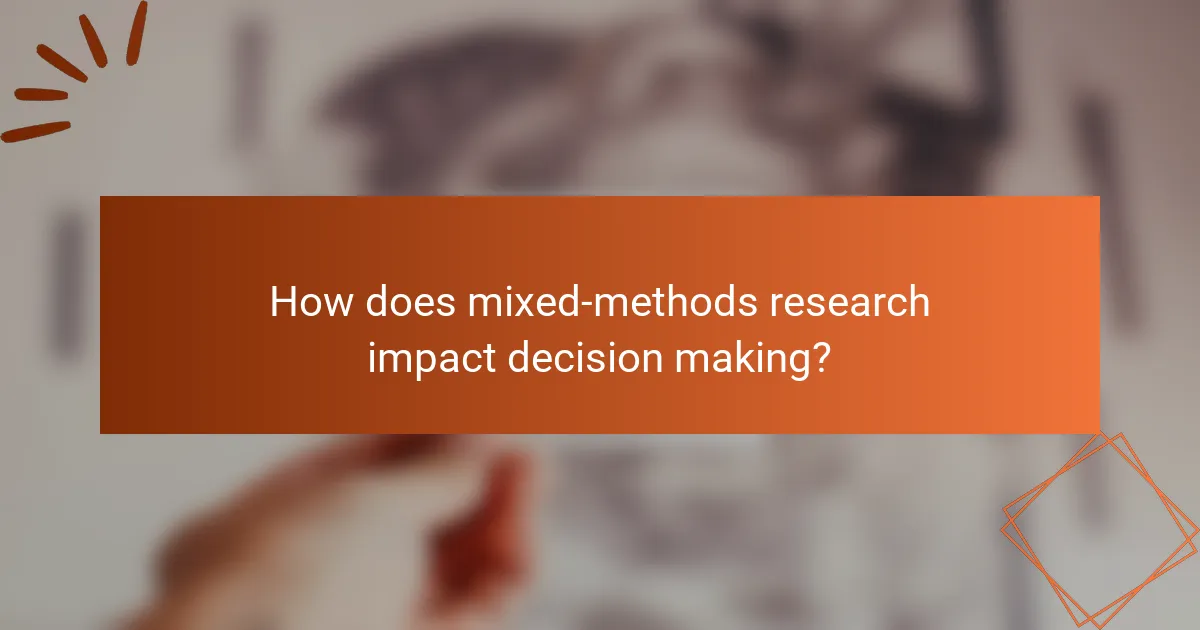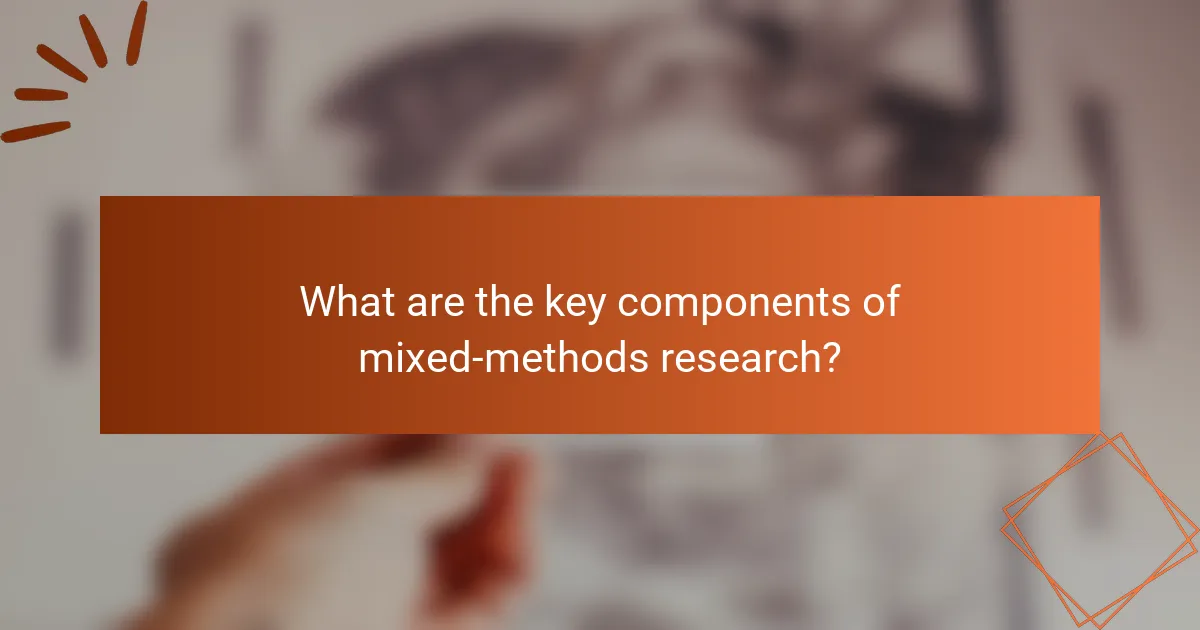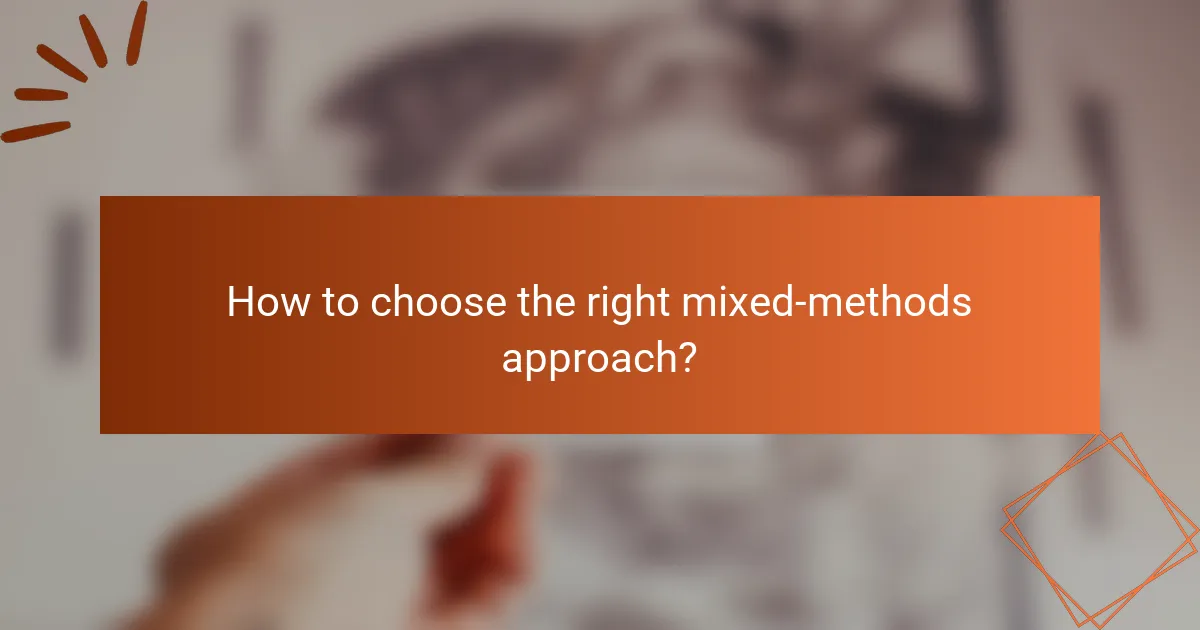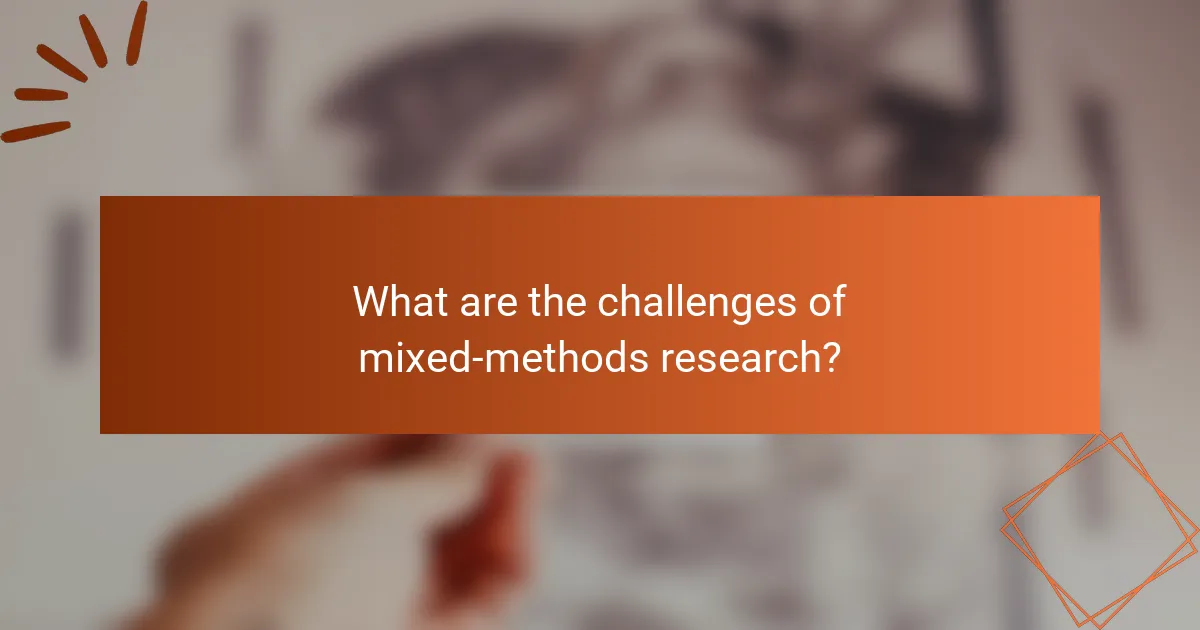Mixed-methods research integrates qualitative and quantitative approaches, offering a comprehensive understanding of complex issues. By combining diverse data sources, this methodology enhances decision-making processes, allowing for richer insights and more informed choices that consider both numerical data and contextual factors.

What are the benefits of mixed-methods research?
Mixed-methods research combines qualitative and quantitative approaches, offering a range of benefits that enhance the overall research process. This methodology allows for a more comprehensive understanding of complex issues by integrating diverse data sources and perspectives.
Comprehensive data insights
Mixed-methods research provides comprehensive data insights by merging numerical data with rich qualitative information. This combination allows researchers to explore not only the “what” but also the “why” behind the data, leading to a deeper understanding of the research topic.
For example, a study on customer satisfaction might use surveys to quantify satisfaction levels while also conducting interviews to uncover the reasons behind those ratings. This dual approach yields a fuller picture of customer experiences.
Enhanced validity and reliability
By employing both qualitative and quantitative methods, mixed-methods research enhances the validity and reliability of findings. Triangulation, or the use of multiple data sources, helps to confirm results and reduces the likelihood of bias.
For instance, if survey results indicate a trend, follow-up interviews can validate those findings by providing context. This dual verification strengthens the overall conclusions drawn from the research.
Flexibility in research design
Mixed-methods research offers flexibility in research design, allowing researchers to adapt their approach based on the study’s needs. This adaptability can involve changing the order of data collection or modifying methods as new insights emerge.
Researchers can start with qualitative interviews to identify key themes and then design quantitative surveys to measure those themes across a larger population. This iterative process can lead to more relevant and impactful research outcomes.
Improved stakeholder engagement
Engaging stakeholders is crucial in research, and mixed-methods approaches facilitate this by incorporating diverse perspectives. Qualitative data can capture stakeholder opinions and experiences, while quantitative data can provide evidence to support decision-making.
For example, involving community members in focus groups can help shape survey questions that reflect their concerns, leading to higher response rates and more relevant data. This engagement fosters trust and collaboration between researchers and stakeholders.

How does mixed-methods research impact decision making?
Mixed-methods research significantly enhances decision making by integrating qualitative and quantitative data, providing a comprehensive view of complex issues. This approach allows decision-makers to understand not just the numbers but also the context behind them, leading to more informed and effective choices.
Informed policy development
Mixed-methods research plays a crucial role in shaping effective policies by combining statistical data with stakeholder perspectives. For instance, when developing public health policies, quantitative data on disease prevalence can be enriched with qualitative insights from community interviews, ensuring that policies address real needs.
To effectively utilize mixed methods in policy development, consider engaging diverse stakeholders early in the research process. This engagement can help identify key issues and ensure that policies are not only data-driven but also contextually relevant.
Data-driven business strategies
In the business realm, mixed-methods research supports the creation of data-driven strategies by merging market analytics with customer feedback. For example, a company might analyze sales data while also conducting focus groups to understand customer motivations, leading to more targeted marketing efforts.
Businesses should prioritize collecting both types of data to capture a holistic view of their market. This approach can help identify trends and opportunities that purely quantitative or qualitative methods might miss, ultimately driving better strategic decisions.
Enhanced program evaluation
Mixed-methods research enhances program evaluation by allowing evaluators to assess both the outcomes and the processes of programs. For example, a nonprofit might measure the effectiveness of a training program through participant surveys (quantitative) while also conducting interviews to gather detailed feedback on the training experience (qualitative).
For effective program evaluation, ensure that both types of data are aligned and complement each other. This alignment can provide a richer understanding of program impact and areas for improvement, leading to more effective adjustments and enhancements.

What are the key components of mixed-methods research?
Mixed-methods research combines qualitative and quantitative approaches to provide a comprehensive understanding of a research problem. This methodology leverages the strengths of both types of data, allowing for richer insights and more informed decision-making.
Qualitative and quantitative approaches
Qualitative approaches focus on understanding phenomena through detailed, subjective insights, often using interviews or focus groups. In contrast, quantitative methods rely on numerical data and statistical analysis to identify patterns and test hypotheses.
When employing mixed-methods research, researchers often start with qualitative data to explore a topic and then use quantitative methods to measure the prevalence of findings. This combination can validate results and enhance the overall robustness of the study.
Data collection techniques
Data collection in mixed-methods research typically involves a variety of techniques. Qualitative data may be gathered through open-ended surveys, interviews, or observations, while quantitative data often comes from structured surveys, experiments, or existing datasets.
Choosing the right techniques is crucial. For example, using a combination of online surveys for quantitative data and in-depth interviews for qualitative insights can yield a more nuanced understanding of the research question.
Integration of findings
Integrating findings from qualitative and quantitative data is essential for mixed-methods research. This process involves comparing and contrasting results to draw comprehensive conclusions that reflect both numerical trends and personal experiences.
Researchers should consider using joint displays or matrices to visually represent how qualitative insights support or contradict quantitative results. This integration not only enhances the validity of the research but also provides a clearer narrative for stakeholders and decision-makers.

What are the prerequisites for conducting mixed-methods research?
Conducting mixed-methods research requires careful planning and consideration of several key factors. These include formulating a clear research question, allocating appropriate resources, and ensuring the team has the necessary expertise.
Research question formulation
Formulating a research question is crucial for mixed-methods research as it guides the entire study. The question should be clear, focused, and capable of being addressed through both qualitative and quantitative approaches. For example, a question like “How does community engagement impact local health outcomes?” allows for diverse data collection methods.
Consider using frameworks such as the PICO (Population, Intervention, Comparison, Outcome) model to structure your question effectively. This can help in identifying the specific elements that will be explored through both qualitative interviews and quantitative surveys.
Resource allocation
Resource allocation involves budgeting time, finances, and personnel effectively to support both qualitative and quantitative components. Ensure that you have sufficient funding to cover data collection tools, participant incentives, and analysis software. A balanced budget might allocate around 40% for qualitative methods and 60% for quantitative methods, depending on the study’s focus.
Additionally, consider the time required for data collection and analysis. Qualitative methods often take longer due to the need for in-depth interviews or focus groups, so plan accordingly to avoid delays in your research timeline.
Team expertise
Having a team with diverse expertise is essential for successful mixed-methods research. Team members should be proficient in both qualitative and quantitative methodologies to ensure a comprehensive approach. For instance, including a statistician alongside a qualitative researcher can enhance the study’s overall rigor.
Evaluate the skills of your team members and consider training or hiring additional staff if necessary. This might involve workshops on qualitative analysis software or statistical methods, ensuring that everyone is equipped to contribute effectively to both aspects of the research.

How to choose the right mixed-methods approach?
Choosing the right mixed-methods approach involves aligning your research objectives with the available resources and understanding the needs of your target audience. This ensures that the selected methods effectively address the research questions while being feasible and relevant.
Understanding research objectives
Clearly defining your research objectives is crucial for selecting an appropriate mixed-methods approach. Consider whether your goals are exploratory, explanatory, or descriptive, as this will guide your choice of qualitative and quantitative methods.
For example, if you aim to explore a new phenomenon, qualitative methods like interviews may be more suitable. Conversely, if you need to measure the impact of a specific intervention, quantitative methods such as surveys could be more effective.
Evaluating available resources
Assessing your available resources is essential when choosing a mixed-methods approach. This includes considering budget constraints, time limitations, and the expertise of your research team. A well-resourced project can afford a more comprehensive approach, while limited resources may necessitate a more focused strategy.
For instance, if funding is tight, you might prioritize one method over another, such as conducting fewer qualitative interviews while still gathering sufficient quantitative data through surveys. Always weigh the trade-offs between depth and breadth based on your resource availability.
Identifying target audience needs
Understanding the needs of your target audience is vital for ensuring that your mixed-methods research is relevant and impactful. Engage with stakeholders to gather insights about their priorities and preferences, which can inform your methodological choices.
For example, if your audience values detailed narratives, incorporating qualitative interviews may enhance the richness of your findings. Alternatively, if they prefer concise data summaries, a stronger emphasis on quantitative analysis might be warranted. Tailoring your approach to audience needs can significantly improve the utility of your research outcomes.

What are the challenges of mixed-methods research?
Mixed-methods research combines qualitative and quantitative approaches, but it faces several challenges that can complicate the research process. Issues such as integrating diverse data types, maintaining methodological rigor, and ensuring clear communication of findings can arise.
Integration of Qualitative and Quantitative Data
One major challenge in mixed-methods research is effectively integrating qualitative and quantitative data. Researchers must determine how to combine these different types of data meaningfully, which often requires careful planning and a clear framework. For instance, using qualitative insights to explain quantitative trends can enhance understanding, but it demands a coherent strategy.
Methodological Rigor
Maintaining methodological rigor is crucial yet challenging in mixed-methods research. Each method has its own standards and best practices, and researchers must ensure that both qualitative and quantitative components are robust. This may involve adhering to specific guidelines, such as those set by the American Psychological Association or similar organizations, depending on the field.
Communication of Findings
Communicating findings from mixed-methods research can be complex, as researchers must present results from both qualitative and quantitative analyses clearly. This often requires careful crafting of narratives that highlight how the two data types complement each other. Using visual aids, such as charts or tables, can help convey the integrated findings effectively.
Resource Allocation
Mixed-methods research can demand significant resources, including time, funding, and expertise. Researchers need to allocate sufficient resources to both qualitative and quantitative components, which can strain budgets and timelines. Planning for these needs early in the research process can help mitigate potential issues.
Ethical Considerations
Ethical considerations are paramount in mixed-methods research, particularly when dealing with sensitive qualitative data. Researchers must ensure that they protect participants’ confidentiality and obtain informed consent for both data types. This may involve additional layers of ethical review, especially when qualitative data is involved.


